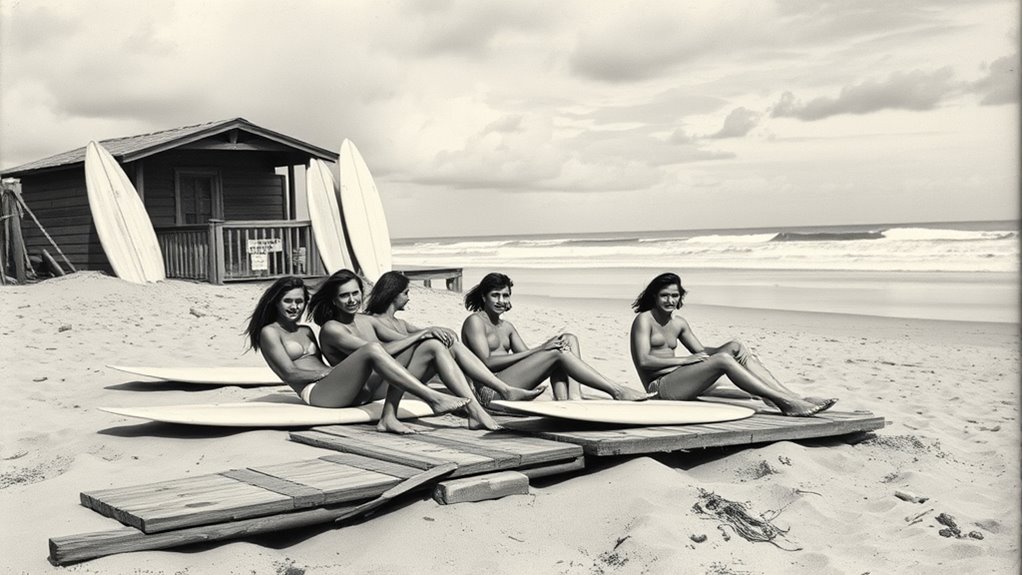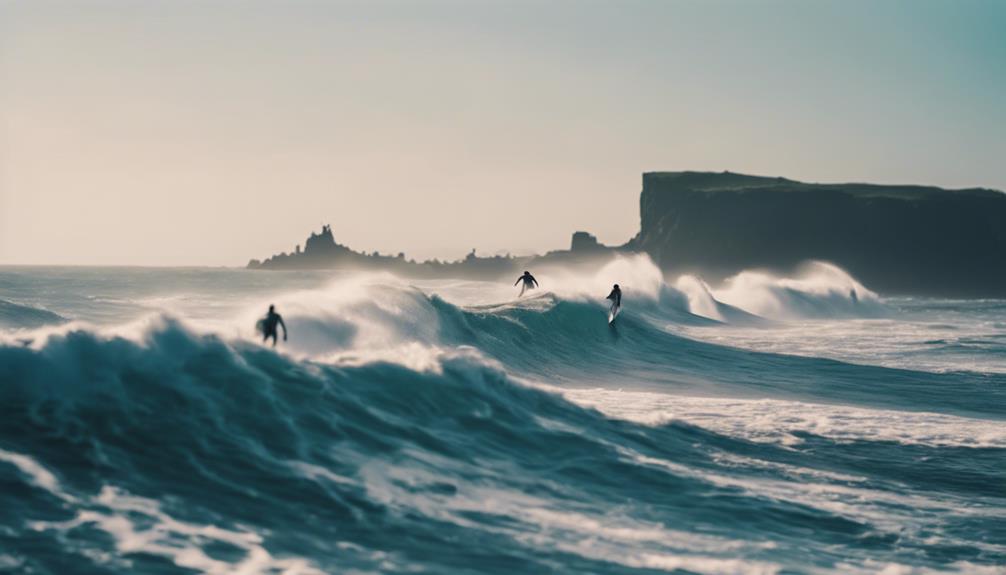Surfing’s history begins over a thousand years ago in Polynesia, where it was more than just a sport—it was a spiritual and social practice linked to divine forces and community status. When it spread to Hawaii, rituals and offerings deepened its cultural significance. In the 20th century, innovations in surfboard design and global popularity transformed it into a worldwide symbol of adventure and freedom. To explore how its rich heritage continues today, keep exploring this fascinating story.
Key Takeaways
- Surfing originated over a thousand years ago in Polynesia, where it held spiritual, social, and ritual significance.
- In Hawaii, surfing became intertwined with sacred rituals, ceremonies, and symbols honoring ocean gods and natural harmony.
- Technological advancements in the 20th century allowed surfers to ride larger waves and led to the global spread of surf culture.
- Modern innovations in surfboard design and media have enhanced performance, accessibility, and the preservation of surfing heritage.
- Contemporary surfing emphasizes sustainability, environmental stewardship, and balancing technological progress with cultural preservation.
Origins of Surfing in Polynesia
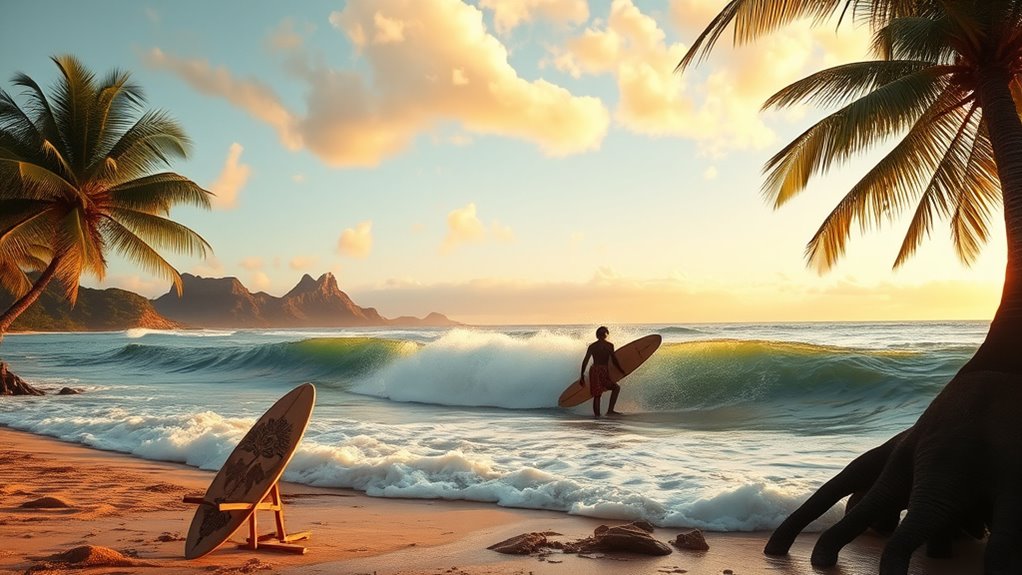
Surfing in Polynesia has deep roots that date back over a thousand years, making it an integral part of the region’s culture. Early Polynesians mastered Polynesian navigation, enabling them to traverse vast ocean distances with remarkable accuracy. This skill wasn’t just for travel; it also influenced their relationship with the sea, including their use of ancient fishing techniques. These techniques required understanding wave patterns and ocean currents, which helped them identify ideal spots for fishing and surfing. Surfing, known as heʻe nalu in Hawaiian, evolved alongside these maritime skills, becoming more than just a way to catch waves—it became a cultural practice linked to social status, spiritual beliefs, and community identity. The mastery of navigation and ocean understanding laid the foundation for surfing’s significance in Polynesian society. Additionally, vibrational awareness played a role in their connection to nature and the ocean’s rhythms, further enriching their cultural practices related to surfing.
Surfing’s Cultural Significance in Ancient Societies
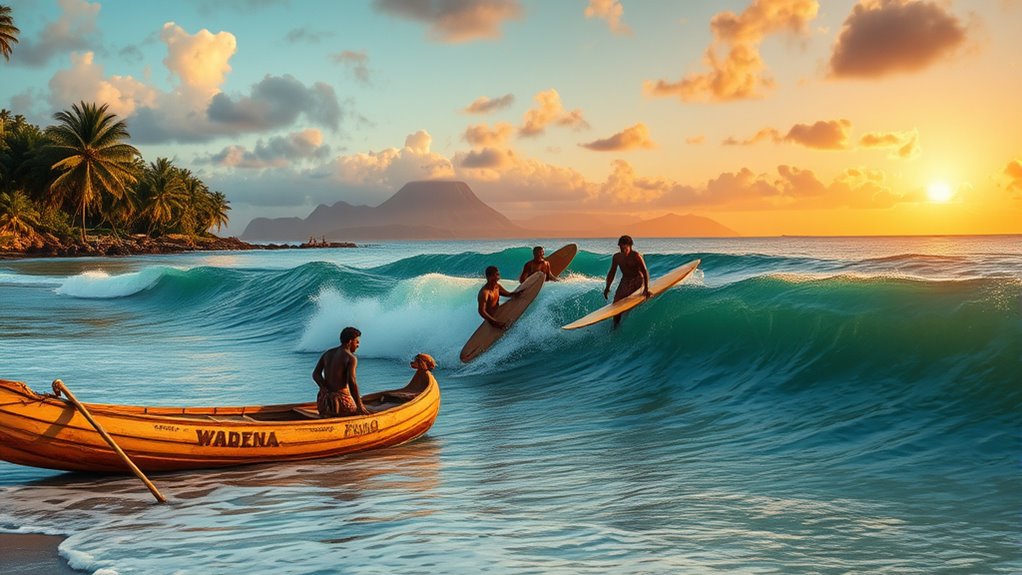
In ancient societies, the act of riding waves transcended mere recreation and became a powerful symbol of social hierarchy, spiritual connection, and cultural identity. Surfing spiritualism played a central role, with wave riding seen as a sacred practice that linked humans to divine forces. Many cultures incorporated surfing into ancient ceremonial practices, where it was considered a rite of passage or a way to honor gods associated with the ocean. Chiefs and high-ranking individuals often participated in these rituals, reinforcing their social status. Surfing was more than sport; it was a spiritual act that embodied harmony with nature and the universe. This deep spiritual significance helped preserve surfing as a crucial cultural tradition across generations in ancient societies. The essential oils used in various healing and ceremonial practices further underscored the connection between nature and spiritual rituals. These rituals often involved offerings and symbols, such as Polynesian symbols for strength, emphasizing the profound relationship between the community, the environment, and the divine.
The Spread of Surfing to Hawaii and Its Rituals
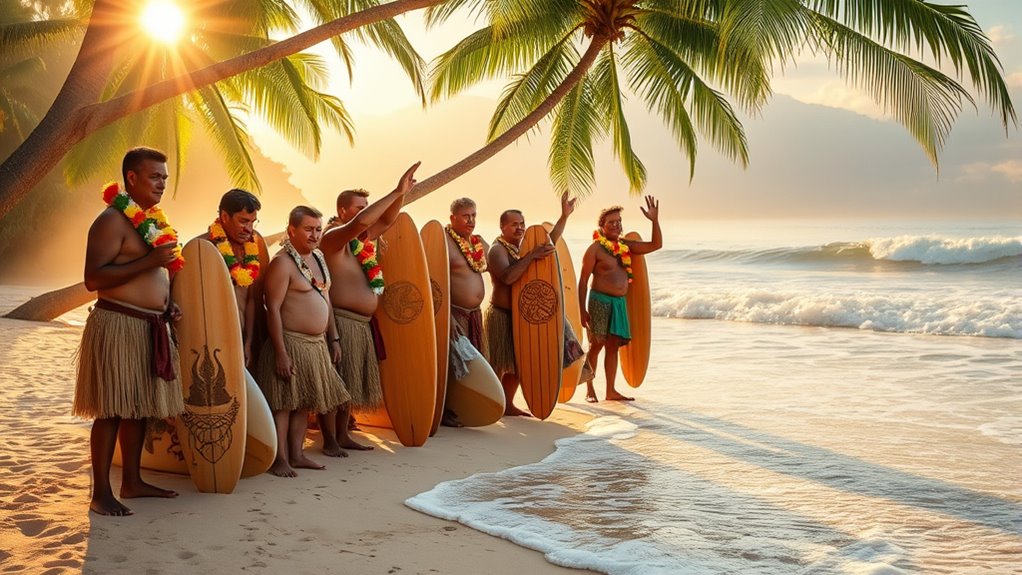
As the ancient Polynesians navigated the vast Pacific, they brought with them a deep reverence for the ocean that would eventually shape Hawaiian surfing traditions. When surfing arrived in Hawaii, it became more than sport; it was woven into Hawaiian culture through sacred rituals and surfing ceremonies. These rituals honored the ocean and the surf gods, emphasizing respect and harmony. Surfing was seen as a spiritual practice, with ceremonies performed before paddling out and after riding waves, reinforcing community bonds and spiritual connection. Surfboards, often carved with symbols, held cultural significance during these rituals. The Hawaiian tribe’s recognition of the ocean as a sacred place reflects their spiritual connection to the Earth, which is central to their cultural identity. This reverence extended to the use of specific rituals and offerings that underscored their spiritual bond with the sea. Incorporating traditional chants and prayers, these rituals further expressed their deep connection and gratitude for the ocean’s gifts. Additionally, the craftsmanship involved in creating traditional carved surfboards demonstrated their artistic and spiritual dedication. The integration of these rituals exemplifies how surfing served as a cultural expression that celebrated the ocean’s power and its sacred place in Hawaiian life.
The Rise of Surfing in the 20th Century

How did surfing transform from a Polynesian cultural practice into a global phenomenon during the 20th century? Advances in wave dynamics understanding allowed surfers to ride larger, more powerful waves. Surfboard manufacturing evolved rapidly, producing lighter, more maneuverable boards that expanded the sport’s reach. This innovation attracted enthusiasts worldwide, fueling a surfing boom. As surf culture spread, competitions and media coverage promoted the sport’s popularity. The combination of technical improvements and cultural appeal made surfing accessible beyond Polynesia, turning it into a mainstream activity. Additionally, the increased understanding of wave dynamics contributed significantly to the development of more daring and diverse surfing techniques. Modern surfboards with advanced features further enhanced performance, encouraging innovation among surfers globally. The rise of surfing technology also played a crucial role in transforming the sport and expanding its appeal worldwide. Furthermore, the development of surfing techniques allowed athletes to push the boundaries of what was previously thought possible on a wave. Recognizing the importance of curiosity-driven innovation, the surfing community continuously explores new methods and equipment to improve their craft.
Surfing and the Development of Surfboard Technology
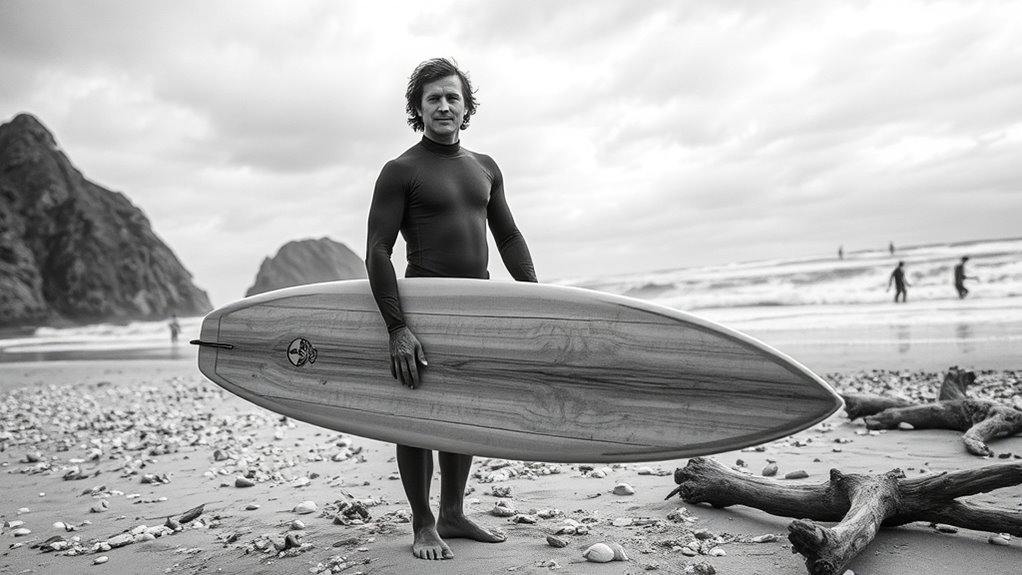
As surfboard technology has evolved, new materials and design innovations have transformed how you ride waves. These advancements improve performance, making surfing more dynamic and accessible. Exploring these developments reveals how they continue to shape the sport today. For example, the use of advanced materials such as lightweight composites and durable polymers has increased the longevity and maneuverability of surfboards. The integration of innovative shaping techniques has also played a crucial role in enhancing control and responsiveness. Additionally, the adoption of sustainable manufacturing practices reflects the growing emphasis on environmental responsibility within surfboard production. The influence of technological innovation continues to push the boundaries of what is possible on a surfboard. Furthermore, ongoing research into performance-enhancing materials drives continuous improvements in surfboard design and functionality.
Evolution of Materials
The evolution of surfboard materials has considerably shaped the development of surfing culture, driving innovations that improve performance and accessibility. Early boards used solid wood, but today, synthetic composites allow for lighter, stronger, and more durable designs. Modern surfers often choose eco-friendly materials to reduce environmental impact, emphasizing sustainability. You can see how these material advancements make surfing more exciting and inclusive. Natural materials like wood and linen have historically contributed to the authentic aesthetic and feel of traditional surfboards, influencing contemporary design choices. Additionally, advancements in self-watering plant pots demonstrate how material innovation continues to impact various fields by promoting sustainability and efficiency. The integration of new composite materials has also enabled the creation of more specialized surfboards tailored for different wave conditions and skill levels. Moreover, sustainable manufacturing practices are increasingly being adopted to further minimize ecological footprints and promote environmental stewardship within the surfing community.
Design Innovations
Innovations in surfboard design have revolutionized surfing by enabling you to perform more dynamic maneuvers and tackle a wider variety of waves. You now benefit from innovative fin designs that improve stability, control, and turning ability, allowing for sharper and more precise maneuvers. Ergonomic surfboard shapes have also emerged, optimizing the rocker, outline, and volume to better match different wave types and riding styles. These design improvements make surfboards more responsive and easier to paddle, giving you greater confidence in challenging conditions. As a result, surfing becomes more accessible and exciting, pushing the boundaries of what’s possible on a wave. These technological advances continue to shape the sport, inspiring both amateurs and professionals alike. Additionally, incorporating advanced materials into surfboard construction enhances durability and performance, further elevating the surfing experience. The ongoing integration of design innovations is pivotal in maintaining the sport’s evolution and expanding its accessibility to new enthusiasts.
Impact on Performance
Advancements in surfboard technology have considerably boosted your ability to perform complex maneuvers and ride a wider variety of waves. These innovations have transformed your wave riding experience, making skill development faster and more accessible. Modern boards, with improved buoyancy and maneuverability, allow you to execute sharp turns and tricks with ease. You can now tackle bigger, more challenging waves confidently. The evolution of materials and shapes has made surfboards lighter yet more durable, enhancing control and responsiveness.
- Better board stability helps you stay balanced during advanced tricks
- Increased speed and agility enable you to catch more waves
- Enhanced responsiveness sharpens your skill development and overall performance
The Emergence of Surfing as a Global Sport and Lifestyle
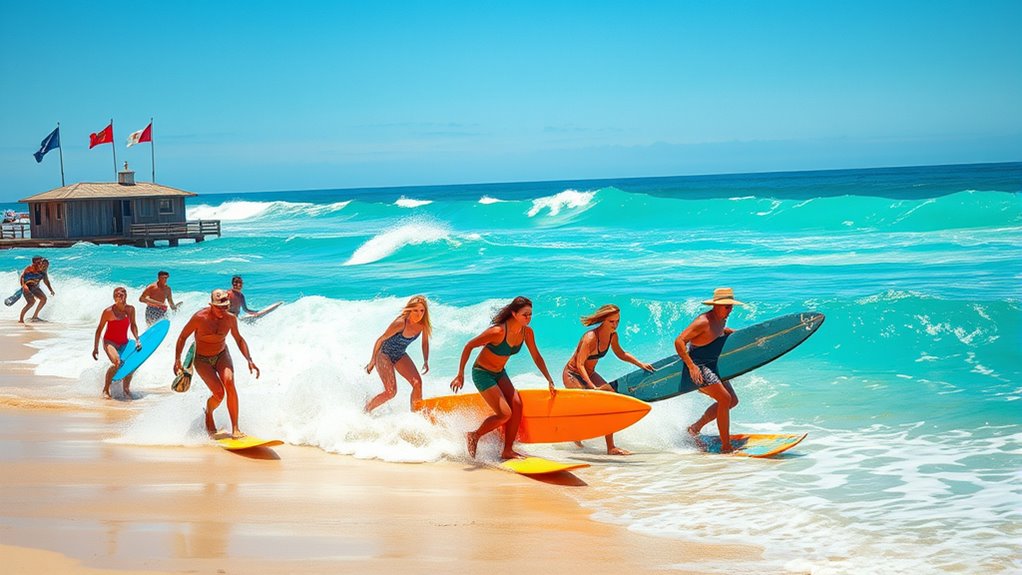
How did surfing transform from a regional Polynesian pastime into a worldwide phenomenon? It started with surfers sharing their skills across oceans, inspiring others and spreading the culture. As surfing gained popularity, brands emerged around surfboard branding, creating a global market that connected surfers everywhere. The adoption of specific surfing attire also played a role, making surfing more accessible and stylish worldwide. Major competitions and media coverage boosted the sport’s visibility, turning it into both a sport and a lifestyle. Today, surfing is embraced globally, blending athleticism with a relaxed attitude. You can now find surf shops, brands, and communities that celebrate this lifestyle, making surfing a symbol of freedom and adventure across different countries and cultures.
Modern Influences and the Preservation of Surfing Heritage

As surfing continues to evolve with modern influences like high-performance technology, social media, and global competitions, there’s also a growing effort to preserve its rich heritage. Digital innovation helps document historic surf spots and legendary surfers, making heritage accessible worldwide. Environmental sustainability becomes a priority, inspiring surfers to protect oceans and coastlines that define the sport. You might notice:
Surfing’s heritage is preserved through digital archives, eco-friendly practices, and global cultural celebrations.
- Virtual archives showcasing vintage surfboards and photos
- Eco-friendly surfboard manufacturing practices
- Social media campaigns celebrating surf culture’s history
These efforts ensure that future generations can appreciate the sport’s roots while embracing modern advances. Balancing innovation with preservation keeps surfing authentic and sustainable, honoring its past amidst ongoing change. Your participation in these initiatives helps safeguard surfing’s legacy for years to come.
Frequently Asked Questions
How Did Surfing Influence Local Polynesian Art and Mythology?
You see, surfing deeply influences Polynesian art and mythology through wave symbolism and Polynesian legends. These legends often depict powerful gods and spirits associated with the ocean, shaping cultural beliefs. Surfing celebrates the connection to nature, inspiring intricate carvings and tattoos that embody wave symbolism. By embracing surfing, you honor these stories and traditions, recognizing the ocean’s essential role in Polynesian identity and spiritual life.
What Are the Traditional Rituals Performed Before Surfing in Ancient Societies?
Imagine you’re about to ride a wave, and the ocean’s spirit is watching. In ancient societies, you’d perform ceremonial dances to honor the sea, seeking its favor. Sacred offerings, like flowers or food, would be presented to appease ocean gods. These rituals symbolize respect and gratitude, connecting you deeply with nature’s power. Such traditions set the tone for a spiritually charged surf, blending reverence with the thrill of riding the waves.
How Did Surfing Become a Symbol of Rebellion in Modern Culture?
You see, surfing became a symbol of rebellion in modern culture through its ties to the counterculture movement of the 1960s and 70s. People embraced surfing as an act of freedom, challenging societal norms. The skateboarding influence helped shape this rebellious spirit, inspiring young surfers to express individuality and defy conventions. Today, surfing’s image as a rebellious activity persists, reflecting a desire for independence and nonconformity.
What Role Did Surfing Play in Environmental Conservation Efforts?
You see, surfing has become a powerful force in environmental conservation by championing marine preservation and coastal activism. As a surfer, you’re often at the forefront of protecting ocean ecosystems, advocating for cleaner beaches, and raising awareness about pollution. Your passion for waves drives you to support initiatives that preserve marine life and coastal areas, making surfing not just a sport but an essential part of environmental advocacy efforts.
How Have Surfboard Designs Evolved With Technological Advances?
You’ll notice that surfboard designs have evolved markedly thanks to innovative materials and design innovations. Modern boards often incorporate lightweight, durable foam cores and fiberglass for better performance and longevity. Technological advances have also introduced shape modifications for improved maneuverability and speed, catering to different surfing styles. As a result, you can now enjoy boards that are more responsive, easier to handle, and tailored to your skill level, enhancing your overall surfing experience.
Conclusion
As you ride the waves of surfing’s rich history, you become part of a timeless dance between culture and nature. From ancient rituals to modern competitions, surfing’s story flows like an endless tide, shaping identities and connecting communities. Embrace this heritage, and remember that each wave you catch is a chapter in a story that keeps evolving—a beautiful, perpetual rhythm that invites you to carry its spirit forward, one surf at a time.

